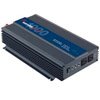Power When Away From Home | Using a Power Inverter
A power inverter takes DC energy from a battery and inverts it to produce traditional AC power. You can use an DC to AC power inverter to supply power to devices such as televisions, microwaves, computers or power tools. They provide power in areas where you normally would not have access to standard 115-120 Volts AC from the power grid (ex: your home wall outlet). You simply connect the inverter to a 12 volt battery and plug your device into the inverter. This is a great solution for having an easy to use, portable power supply.
 There are many kinds of inverters and many different sources from which they convert power. Some smaller 12 volt inverters convert power from your car battery through the cigarette lighter port on the dashboard. With other kinds of inverters it is important to match them with batteries of the proper type and size. It is important to be discriminating in the purchasing process. If you are using a small inverter with an automotive battery this will work sufficiently. Most car batteries will supply enough power for 30 to 60 minutes before they need to be recharged. You can recharge your battery by either turning on the engine, using a gas generator, or hooking it up to an AC charger. If using your car battery, be sure to run the engine for approximately 10 minutes every hour to keep the battery charged.
There are many kinds of inverters and many different sources from which they convert power. Some smaller 12 volt inverters convert power from your car battery through the cigarette lighter port on the dashboard. With other kinds of inverters it is important to match them with batteries of the proper type and size. It is important to be discriminating in the purchasing process. If you are using a small inverter with an automotive battery this will work sufficiently. Most car batteries will supply enough power for 30 to 60 minutes before they need to be recharged. You can recharge your battery by either turning on the engine, using a gas generator, or hooking it up to an AC charger. If using your car battery, be sure to run the engine for approximately 10 minutes every hour to keep the battery charged.
The length of runtime that the battery will provide largely depends on the kind of device you are running. If your appliance needs a steady supply of power for a long period of time, that can put a heavy load on the battery. Therefore it is not advised to use your car or truck battery in this situation. The battery can be easily drained to the point where it no longer hold the power necessary to start the engine. This will prevent you from recharging the battery using the vehicle's alternator. Draining a starter battery like this on a regular basis will harm it and significantly shorten the expected life span.
If you need to run a heavy load through a larger inverter from a car or truck battery, you should only do this while the vehicle is running. Otherwise we recommend you use a deep cycle battery, such as an RV battery and Marine battery. If you are using a 600 watt inverter or larger, Marine batteries are preferable because they have the capability to withstand being drained deeply and recharged many times. These deep cycle batteries should give you several hundred cycles of charging and discharging. A good rule thumb for batteries is they should not be drained beyond 50% capacity. If you so, it can significantly shorten the life of the battery. If you need more power or longer runtime, you can connect several batteries together in parallel. Creating battery banks is a good alternative to buying a larger battery. Remember, when configuring batteries in parallel, it should done with 12 volt batteries of the same type as one another. Using an inverter to generate power from a battery can be an invaluable resource for anyone who finds themselves away from traditional AC power sources.
 If you can, try to use a Pure Sine Wave inverter. The pure sine wave is better for applications, especially those that have sensitive electronic components. The other option, the modified sine wave inverter is less expensive but good for simple applications such as radios. The difference is this: The pure sine wave is natural and the wave is curved. From peak to peak there is a full range of frequency in-between. Modified sine waves are rigid waves, only outputting the top peak and the lower peak alternatively, with no range in-between. Our high end inverters are pure sine wave. We believe that's the best way to get the AC power you need.
If you can, try to use a Pure Sine Wave inverter. The pure sine wave is better for applications, especially those that have sensitive electronic components. The other option, the modified sine wave inverter is less expensive but good for simple applications such as radios. The difference is this: The pure sine wave is natural and the wave is curved. From peak to peak there is a full range of frequency in-between. Modified sine waves are rigid waves, only outputting the top peak and the lower peak alternatively, with no range in-between. Our high end inverters are pure sine wave. We believe that's the best way to get the AC power you need.



